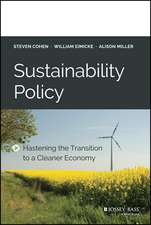Kazakstan 1993 – 2000: Independent Advisors and the IMF
Autor Lutz Hoffmann Traducere de T. A. Galloway Contribuţii de K. Dittmann Autor Peter Bofinger Contribuţii de H. Engerer Autor Heiner Flassbeck Contribuţii de C.van Hirschhausen Autor Alfred Steinherr Contribuţii de R. Pohl, T. Ribakova, F. Spiecker, D. Vesper, R. Zwieneren Limba Engleză Paperback – 27 noi 2000
The topics are dealt with in a new form of presentation, collecting the papers of the advisory group in chronological order.
Preț: 387.96 lei
Nou
Puncte Express: 582
Preț estimativ în valută:
74.24€ • 77.70$ • 61.79£
74.24€ • 77.70$ • 61.79£
Carte tipărită la comandă
Livrare economică 31 martie-14 aprilie
Preluare comenzi: 021 569.72.76
Specificații
ISBN-13: 9783790813555
ISBN-10: 3790813559
Pagini: 292
Ilustrații: XII, 278 p. 3 illus.
Dimensiuni: 155 x 235 x 15 mm
Greutate: 0.41 kg
Ediția:Softcover reprint of the original 1st ed. 2001
Editura: Physica-Verlag HD
Colecția Physica
Locul publicării:Heidelberg, Germany
ISBN-10: 3790813559
Pagini: 292
Ilustrații: XII, 278 p. 3 illus.
Dimensiuni: 155 x 235 x 15 mm
Greutate: 0.41 kg
Ediția:Softcover reprint of the original 1st ed. 2001
Editura: Physica-Verlag HD
Colecția Physica
Locul publicării:Heidelberg, Germany
Public țintă
ResearchCuprins
The Project Response to Real Needs.- Kazakstan Before the Currency Reform (August 1995)..- I: How to Tame Hyperinflation?.- A Stabilization Program for Kazakstan: Capitalizing on the Opportunities of a New Currency (December 1993).- Stabilization of the Tenge: Measures for 1994 (February 1994).- Stabilization of Prices in the Second Half of 1994 (August 1994).- Continuing Stabilization, Introducing Growth (September 1994).- II: Economic Crisis and Controversy with the IMF.- Key Issues (March 1995).- Learning from Mistakes (April 1995).- Overcoming the Deadlock between Macroeconomic and Microeconomic Policy in Kazakstan (August 1995).- Kazakstan between Stability and Growth (February 1996).- The Economic Situation and General Economic Policy in Kazakstan at the Start of 1997 (February 1997).- Annex:.- How the CIS-3 Achieved Macroeconomic Stabilization (April 1996).- III: Fiscal Policy and Natural Resources.- Financing Public Expenditures (August 1996).- Basic Principles for Government Borrowing Policy (November 1996).- Much Ado AboutChrw(133)Little? Disenchantment in the Kazak and Caspian Oil and Gas Sectors (September 1998).- Annex 1:.- The Public Sector in Transition Economies: Developments in Kazakstan (September 1996).- Annex 2:.- Export Performance of the Economy of Kazakstan (February 1998).- IV: Inter-enterprise Arrears and Pension Reform.- A Proposal for Solving the Problem of Inter-enterprise Debt (December 1996).- A Concrete Program for Eliminating Inter-enterprise Debt (March 1997).- Problems of a Funded System for Pensions in Kazakstan (June 1997).- The Demonetized Economy: Causes and Solutions (November 1999).- The State of Kazakstan’s Pension Reform (November 1999).- Annex-.- Are Funded Pensions Better than a Pay-As-You-Go System? - A Critical View onKazakstan’s Pension Reform (November 1997).- V: Kazakstan and the Asian Crisis.- In the Shadow of the Asian Crisis and the Devaluation of the Rouble (August 1998).- Kazakstan’s Policy Options in Face of the Russian Crisis (February 1999).- Currency and Budgetary Policy after the Devaluation of the Tenge (July 1999).- Annex:.- Crawling Peg: An Optimal Strategy for Kazakstan? (March 2000).- Conclusion.- Chronology of Events (1993-2000).- List of Authors.
Textul de pe ultima copertă
By introducing a new national currency in November 1993, the Republic of Kazakstan took a decisive step towards establishing its political and economic independence. In the following years, Kazakstan made great efforts to lay the institutional foundation for econonmic policy in line with a free market system. The cooperation between Kazak experts and independent international advisors such as the group of German econonmists under the leadership of Lutz Hoffmann played an important role for the Kazak government in choosing the most effective concepts and instruments for economic policy. Thus, the main topic of this book is the discussion of the macroeconomic problems during the first years of transition and the role of international financial institutions, in particular the International Monetary Fund.
The topics are dealt with in a new form of presentation, collecting the papers of the advisory group in chronological order.
The topics are dealt with in a new form of presentation, collecting the papers of the advisory group in chronological order.








